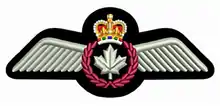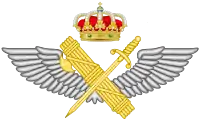Aviator badge
An aviator badge is an insignia used in most of the world's militaries to designate those who have received training and qualification in military aviation. Also known as a Pilot's Badge, or Pilot Wings, the Aviator Badge was first conceived to recognize the training that military aviators receive, as well as provide a means to outwardly differentiate between military pilots and the “foot soldiers” of the regular ground forces.
United States
A Military Aviator badge existed from 1912-17 before being replaced by the predecessor of the "wings" badge.

A United States Aviator Badge refers to three types of aviation badges issued by the United States Armed Forces, those being for Air Force, Army, and Naval (to include Marine and Coast Guard) aviation.
Air Force and Army Aviator Badges are issued in three ratings: Basic, Senior, and Command (Air Force)/Master (Army). The higher degrees are denoted by a star or star with wreath above the badge. Air Force regulations state that the basic rating denotes completion of specified training and that the advanced ratings denote experience levels. The Naval Aviator Badge is issued in a single rating for Navy, Marine Corps, and Coast Guard aviators.United Kingdom
The current aviator badge of the Royal Air Force has been in use since the Second World War. The badge consists of a winged crown and wreath, beneath which are the letters "RAF". The Royal Air Force also uses a "half wing" version to denote Weapon System Officers (WSOs) and Weapon System Operators (WSOps) as well as various airborne roles such as Airborne Technician.
Royal Air Force
.jpg.webp)
In the RAF, the Flying Badge (colloquially referred to as wings or a brevet), is awarded upon the completion of a significant stage of flying training. Aircrew first undertake Elementary Flying Training, and are then streamed to either fast jet, helicopter, RPAS or multi-engine pipelines. The award of wings usually occurs upon completion of the secondary phase of training; for example, in the fast jet stream, wings are awarded upon completion of the Basic Fast Jet Course (BJFT), currently at RAF Linton-on-Ouse; for helicopter pilots, wings are awarded after they complete helicopter training at RAF Shawbury pre-OCU; for RPAS post-FTU (Formal Training Unit)[1] and on the attainment of 'Limited Combat Ready' status, and for multi-engine aircrew, wings are awarded upon completion of their Multi-Engine Advanced Flying Training (MEAFT) training at RAF Cranwell. Aircrew, other than RPAS pilots, are then posted to their Operational Conversion Units having gained their wings, but still have a good deal of training and type familiarisation to complete before they are considered operational or front-line aircrew.
Current Flying Badges
- pilots wear the letters "RAF" in a brown laurel wreath, surmounted by St Edwards crown ( the crown worn by the sovereign on state occasions), with a swift's wing on each side.
- weapons systems officers/operators (rear aircrew) wear the letters "RAF" in a brown laurel wreath, surmounted by a crown, with a single swift's wing on one side.
Legacy Rear Aircrew who qualified prior to April 2003, wear a single wing with no crown and a letter or letters (denoting speciality) in a brown laurel wreath, however, they may choose to wear the new WSO/WSOP Flying Badge. Legacy flying badges still in use in the RAF but no longer issued, include:
- "N" for Navigator
- "AE" for Air Electronics Officer/Operator
- "LM" for Air Loadmaster
- "E" for Air Engineer
- "S" for Air Signaller (Airborne Linguist)
For other members of a flying crew, who are not de facto Aircrew (but since 1 Apr 20 have been known as Airborne Specialists) and who come from ground trades/branches but are assigned to flying duties, they are awarded an Airborne Specialist Flying Badge upon completion of a bespoke flying training course, which is a half wing, without crown and 2 letters in the centre. This includes:
- "FC" (fighter controller) flying badge – Air Battle Managers assigned to fly on Sentry AEW.1.
- "AT" (airborne technician) flying badge – Ground Engineers assigned to fly on Sentry AEW.1 and RC-135W Rivet Joint platforms as in-flight technicians.
- "IA" (Airborne imagery analyst) flying badge – Intelligence Analysts assigned to fly on Sentinel R.1 in an Airborne Imagery Analyst role .
RAF Catering Stewards assigned to fly as cabin crew on Voyager KC.1, BAe 146 and HS 125 are awarded the "CC" (cabin crew) badge. This badge is worn on the right sleeve in the same location as the parachute qualification, has two upturned wings (similar to Royal Navy ratings' aircrewman badges) and has cream stitching for the wings, lettering and laurels. Legacy Cabin Crew who qualified with the former "AS" (air steward) badge are still entitled to wear it.
Parachute Jumping Instructors (PJIs) are honorary aircrew and wear an open parachute instead of a letter on a half wing.
Obsolete Flying Badges

There are also a number of obsolete rear aircrew flying badges that are no longer in use such as:
- "AG" for Air Gunner
- "B" for Air Bomber
- "RO" for Radio Observer
- "M" (meteorological observer)
- "QM" (air quartermaster)
- Observers wore a single wing attached directly to the letter "O", this was replaced by the Navigator's badge in 1942.
- RPAS pilots initially had a separate flying badge, similar to traditional pilot wings excepting a light blue wreath, this was withdrawn on 1 April 2019.
Royal Navy
The Royal Navy's Fleet Air Arm has its own wings design, bestowed in 1925 when it was the Fleet Air Arm of the Royal Air Force, featuring albatross wings instead of the wings of an eagle, as per the RAF design. The Fleet Air Arm wings badges also feature a crown and fouled anchor, reflecting the naval aspect of the flying undertaken. They are worn on the left sleeve of naval aviators, above the rank "rings" as opposed to on the left breast of uniforms, like the RAF and Army Air Corps. Unlike the RAF and the Army Air Corps, Naval aircrew are awarded their wings after Operational Conversion Unit (OCU), whereupon they are posted to a frontline squadron, the majority of their flying training complete. Therefore, while a Navy and RAF aircrew might take a similar amount of time to reach an operational squadron, the Naval officer has to wait until he has completed his conversion training to receive his wings.
Royal Naval Observers are awarded their own aircrew flying badge, consisting of shorter wings either side of a fouled anchor surmounted by a Crown.
Royal Naval Aircrewmen are awarded a flying badge similar in shape to the Observer wings, with slightly narrower wings and a similar anchor, but with no crown. Both observers and aircrewmen are also issued Wings upon completion of their OCU, like Royal Navy pilots.[2]
All Royal Navy aircrew wear their wings on the left sleeve of the Number 1 dress uniform jacket, above any rank insignia.[3]
British Army
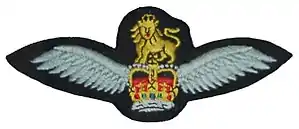
The Army Air Corps pilot wings are awarded upon completion of the basic helicopter course at RAF Shawbury and a subsequent Army course at Middle Wallop Airfield. Aircrew are then dispatched to their OCU to receive type training on either the Apache attack helicopter or the Wildcat battlefield support helicopter.[4]
The Army is unique in the British military in that both Officers and Non-Commissioned Officers can become aircrew and aircraft commanders. The wings are identical for both Officers and Other Ranks, and are worn on the left chest above any medals, similar to the RAF.
In all the services, award of wings does not confer any operational capability – this is declared by a front-line squadron once the student has reached satisfactory standard to allow them to be deployed operationally. This milestone, or 'Combat Ready Status', is the threshold necessary for the award of Flying Pay, a discretionary additional salary bonus for aircrew due to the nature of their work.
Australia
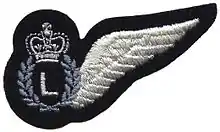
Royal Australian Air Force flying badges differ from those in the RAF mainly in having a crown on all Flying Badges (not just on pilot's wings) and in normally having blue wreaths. The pilot's flying badge has the letters "RAAF". A similar twin-wing badge, bearing the Southern Cross, was introduced for officer aircrew in 1998, replacing various single-wing flying badges previously worn by commissioned officers;[5] however NCO aircrew continue to wear the old single-wing badges.
Some RAAF pilots signed a petition in 1998/1999 in protest of non-pilot "officer aircrew" receiving a double wing. It was rumoured that some serving navigators and war veterans who had previously held the soon to be abolished 'half' wing agreed with the protest. The petition ultimately had over 10,000 signatures, but in the end the petition was unsuccessful.[6]
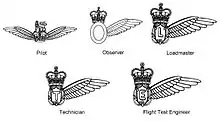
New Zealand
New Zealand uses similar insignia to the United Kingdom, except the pilot's wings bear the letters "NZ" instead of "RAF" and the single wing of other aircrew still have the letters of the trade they represent. Currently these are air warfare officer and air warfare specialist (both wear AW), air engineer (E), air loadmaster (LM), helicopter loadmaster (HL), flight steward (FS), air ordnanceman (AO), and parachute jump instructor (a parachute). Air electronics operator (AE) and Helicopter crewman (HC) are obsolete.
Belgium
The current aviator badge of the Belgian Air Force is:
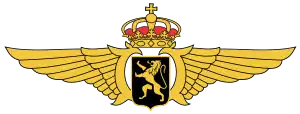
Denmark
The aviator badge of the Royal Danish Air Force is:

China
The emblem of the People's Liberation Army Air Force is:
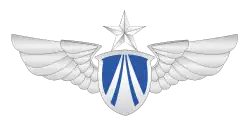
France
| Wikimedia Commons has media related to Aviator badges. |
The aviator badges of the French Air Force/Armée de l'air française and French Navy/Force maritime de l'aéronautique navale are:
 Pilot's Badge
Pilot's Badge Observer's Badge
Observer's Badge Navigator's Badge
Navigator's Badge Flight Doctor's Badge
Flight Doctor's Badge Air Force Flight Nurse
Air Force Flight Nurse Air Force Patient Pilot
Air Force Patient Pilot
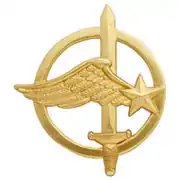
 Naval Pilot's Badge
Naval Pilot's Badge
Germany
1913-1920
Several badges were donated to German aircrew prior, during or after the First World War. The most notable were:[7][8]
 badge for navy pilots from seaplanes 1913
badge for navy pilots from seaplanes 1913 badge for observation officers from airplanes 1914
badge for observation officers from airplanes 1914
The military pilot badge (Abzeichen Militär-Flugzeugführer) was donated on January 27, 1913 by Emperor Wilhelm II. It could be awarded to officers, NCOs and crews who, after completing the two required tests for pilots and after completing their training at a military air base, acquired the certificate as a military pilot issued by the military air and land transportation inspection (Inspektion des Militär-Luft- und Kraft-Fahrtwesens). A similar badge for military pilots was donated on 4 February 1913 by Prince Ludwig from Bavaria.
The badge for navy pilots on seaplanes (Abzeichen für Marine Flugzeugführer auf Seeflugzeugen) was donated on 31 May 1913 by King and Emperor Wilhelm II, for all officers and soldiers, who successfully completed the training on a naval aircraft station and thus received a certificate of qualification as a naval pilot.
The badge for navy pilots on land planes (Abzeichen für Marine Flugzeugführer auf Landflugzeugen) was donated on 23 February 1915 by emperor Wilhelm II for pilots of the Navy, who completed their service in the war on land planes.
The badge for observation officers from airplanes (Abzeichen für Beobachtungsoffiziere aus Flugzeugen) was donated on January 27, 1914 by emperor Wilhelm II. Prerequisites for the award were: 1. a distance traveled of at least 1000 km in an aircraft, 2. a successfully completed technical assistance examination on an aircraft, 3. pass of at least one retake, 4. accomplished exploration missions, and 5. a certification as an observation officer. A similar badge was donated by King Ludwig III. on 3 March 1914 for the Bavarian army.
The airgunner badge (Abzeichen Flugzeug-Fliegerschützen) was founded on January 27, 1918 by emperor Wilhelm II. The soldiers had to demonstrate in-depth knowledge in engine construction and operation, in flight training, in map reading, in the tactics of aerial combat, in theory of bombing, and skills in the operation of machine guns on the ground and in aerial combat.
The commemorative badge for airship crews (Erinnerungsabzeichen für Besatzungen der Luftschiffe) was donated in 1920 by Reichswehr Minister Otto Gessler. There were two versions for Army and Navy airships. Upon request, it was awarded to officers, deck officers, NCOs and crews of former airship crews, who during the war had at least one year of activity on front aircraft.
1935-1945

The Pilotenabzeichen (Pilot's Badge) of the former Luftwaffe had been instituted by Hermann Göring on 12 August 1935. It came in distinct types; nickel silver (changed to zinc during the war) and a variant made of gold.[9] It depicts a silver eagle perched atop a swastika, wings open in a landing pose, and surrounded by a wreath with laurel on the right side and oak branches on the left side, respectively.[10] It was worn in the center of the left breast pocket of the service tunic, underneath the Iron Cross 1st Class if awarded.[11] The badge was awarded after one completed flight training and the flying licence and citation were received.[10]
After 1955

In the Bundeswehr the aviation badge (Tätigkeitsabzeichen Militärluftfahrzeugführer) comes in three grades: bronze (Standard Pilot), silver (Senior Pilot) after 1200 flight hours and gold (Command Pilot) after 1800 flight hours. It depicts the Bundesadler surrounded by an oak leaf wreath between two wings. It is worn above the right breast pocket. A total of two Tätigkeitsabzeichen may be worn, one of which can be foreign in which case the foreign one would be worn below the German one.[12]
Hungary
1938-1945
Pilots and navigators of the Royal Hungarian Air Force wore their aviator rating badge sewn on their uniforms right breast above the pocketflap. The Observers Badge was the same, except without the Holy Crown of Hungary. A smaller version of the pilot's badge which was worn on the lower left sleeve of the overcoat - observers also worn a small insignia without the crown on their sleeve.[13] During World War II a gilded bronze pilot and observer badge was also introduced.
 Royal Hungarian Air Force Pilots Badge sewn version |
 Royal Hungarian Air Force Pilots Badge metal version |
 Royal Hungarian Air Force Observers Badge metal version |
After 1990
After the withdrawal of Soviet forces from Hungary a new Hungarian Air Force was created. It took on the traditions of the Royal Hungarian Air Force. There are 4 classes of pilots badges. Gold laurel 1st class aviator; 1st class aviator, 2nd class aviator, and 3rd class aviator.

 1st class aviator badge |
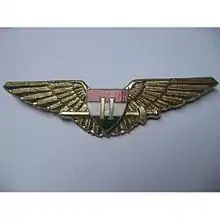 2nd class aviator badge |
 3rd class aviator badge |
Israel
The current badge of a pilot in the Israeli defense forces is:

Namibia
The aviator badge of the Namibian Air Force is:
The Netherlands
The aviator badge of the Royal Netherlands Air Force and the Royal Netherlands Navy is:
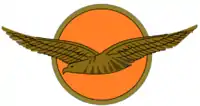
Poland
The current aviator badge of the Polish Air Force has been in use since the 1920s. The badge is called gapa and represents silver eagle in flight with gold laurel wreath in the bill. Navigator/Observer badge (below) represents the same eagle, but in gold with added lightning bolts. It is unlike any other in the other air forces in the world. The gapa was worn in the usual place on the upper left breast above the pocket, but with a chain. It proudly adorned the uniform of Polish Air Force officers in the RAF during World War II along with their RAF wings. In combat badges (for at least 7 flights in combat conditions) the laurel wreath is green.
| Badge | Pilot | Observer | |||||
|---|---|---|---|---|---|---|---|
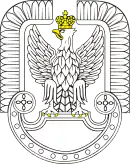 Air Forces |
 |
 | |||||
| Pilot | Observer | ||||||
| Abbreviation | pil. | obs. | |||||
South Africa
The current aviator badge of the South African Air Force has been in use since 2002, when South Africa adopted a new coat of arms. Like the RAF, the SAAF also has a half-wing version of the badge, in this case for navigators. The aviator and navigator badges comes in three grades: bronze, silver and gold. Reserve force aviator badges have a light blue inlay around the coat of arms as appose to the dark blue of permanent air force aviators.
Turkey

Notes
- "RAF Recruitment | RPAS Pilot | Royal Air Force". www.raf.mod.uk. Retrieved 2020-04-17.
- "Aviators get their Flying Wings | Royal Navy". www.royalnavy.mod.uk. Retrieved 2020-04-17.
- "Royal Navy BR3 - Dress Regulations" (PDF).
- "Janes | Latest defence and security news". Janes.com. Retrieved 2020-06-06.
- "Brevets signal start". Air Force News. 48 (14). 10 August 2006. Archived from the original on 4 March 2016. Retrieved 7 December 2015.
- "ID Badges Used in War History". idcardkits.com. 2015. Archived from the original on 5 March 2016. Retrieved 7 December 2015.
- André Hüsken (2001). Katalog der Orden, Ehrenzeichen und Auszeichnungen des Kurfürstentums Brandenburg, der Markgrafschaften Brandenburg-Ansbach und Brandenburg-Bayreuth, des Königreiches Preußen, der Republik Preußen unter Berücksichtigung des Deutschen Reiches / 3, Ehrenzeichen, Auszeichnungen und Ehrengaben 1888-1935. Bremen: Hauschild. ISBN 3897571382. OCLC 314298345.
- Nimmergut, Jörg. (2001). Deutsche Orden und Ehrenzeichen bis 1945 / 4 Württemberg II - Deutsches Reich. München: Zentralstelle für wiss. Ordenskunde. ISBN 3000013962. OCLC 163184635.
- Ailsby 2003, pp. 59, 60.
- Ailsby 2003, p. 59.
- Angolia 1987, p. 162.
- ZDv 37/10 Anzugordnung für die Bundeswehr
- http://members.shaw.ca/czink/index_files/images/MARCH%20APRIL%202003.pdf
